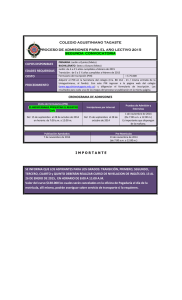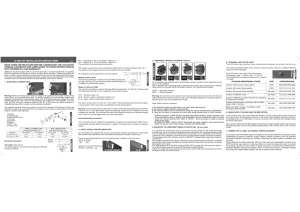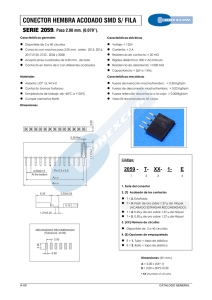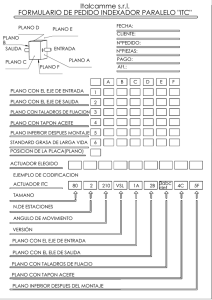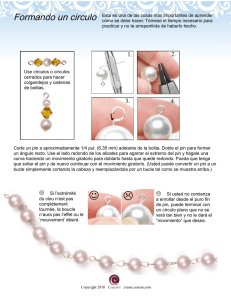descargar
Anuncio
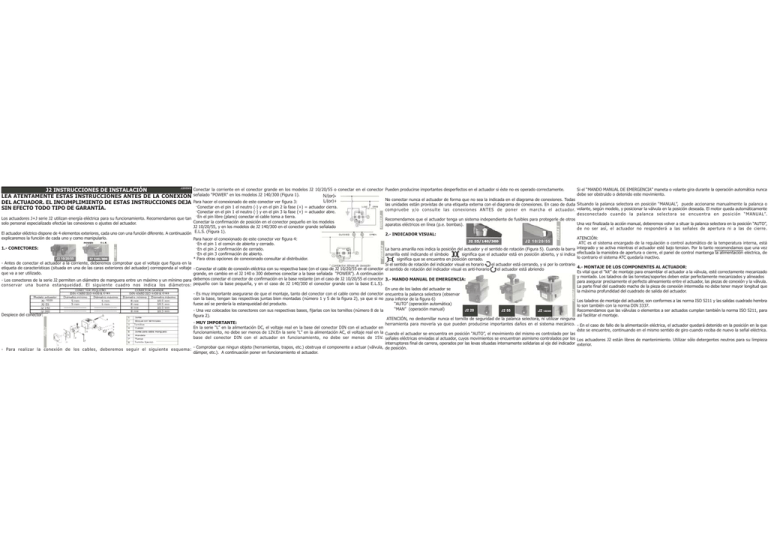
J2IISV2 J2 INSTRUCCIONES DE INSTALACIÓN LEA ATENTAMENTE ESTAS INSTRUCCIONES ANTES DE LA CONEXIÓN DEL ACTUADOR. EL INCUMPLIMIENTO DE ESTAS INSTRUCCIONES DEJA SIN EFECTO TODO TIPO DE GARANTÍA. Los actuadores J+J serie J2 utilizan energía eléctrica para su funcionamiento. Recomendamos que tan solo personal especializado efectúe las conexiones o ajustes del actuador. El actuador eléctrico dispone de 4 elementos exteriores, cada uno con una función diferente. A continuación explicaremos la función de cada uno y como manipularlo. 1.- CONECTORES: J2 10/20/55 - Antes de conectar el actuador a la corriente, deberemos comprobar que el voltaje que figura en la etiqueta de características (situada en una de las caras exteriores del actuador) corresponda al voltaje que va a ser utilizado. - Los conectores de la serie J2 permiten un diámetro de manguera entre un máximo y un mínimo para conservar una buena estanqueidad. El siguiente cuadro nos indica los diámetros: C183 C193 10/20 Despiece del conector: Conectar la corriente en el conector grande en los modelos J2 10/20/55 o conectar en el conector Pueden producirse importantes desperfectos en el actuador si éste no es operado correctamente. señalado "POWER" en los modelos J2 140/300 (Figura 1). No conectar nunca el actuador de forma que no sea la indicada en el diagrama de conexiones. Todas Para hacer el conexionado de este conector ver figura 3: las unidades están provistas de una etiqueta externa con el diagrama de conexiones. En caso de duda ·Conectar en el pin 1 el neutro (-) y en el pin 2 la fase (+) = actuador cierra. compruebe y/o consulte las conexiones ANTES de poner en marcha el actuador. ·Conectar en el pin 1 el neutro (-) y en el pin 3 la fase (+) = actuador abre. ·En el pin libre (plano) conectar el cable toma a tierra. Recomendamos que el actuador tenga un sistema independiente de fusibles para protegerle de otros Conectar la confirmación de posición en el conector pequeño en los modelos aparatos eléctricos en línea (p.e. bombas). J2 10/20/55, y en los modelos de J2 140/300 en el conector grande señalado E.L.S. (Figura 1). 2.- INDICADOR VISUAL: Para hacer el conexionado de este conector ver figura 4: J2 10/20/ 55 ·En el pin 1 el común de abierto y cerrado. ·En el pin 2 confirmación de cerrado. La barra amarilla nos indica la posición del actuador y el sentido de rotación (Figura 5). Cuando la barra ·En el pin 3 confirmación de abierto. amarilla esté indicando el símbolo significa que el actuador está en posición abierto, y si indica * Para otras opciones de conexionado consultar al distribuidor. significa que se encuentra en posición cerrado. Si el sentido de rotación del indicador visual es horario el actuador está cerrando, y si por lo contrario - Conectar el cable de conexión eléctrica con su respectiva base (en el caso de J2 10/20/55 en el conector el sentido de rotación del indicador visual es anti-horario el actuador está abriendo grande, en cambio en el J2 140 o 300 debemos conectar a la base señalada POWER). A continuación debemos conectar el conector de confirmación en la base restante (en el caso de J2 10/20/55 el conector 3.- MANDO MANUAL DE EMERGENCIA: pequeño con la base pequeña, y en el caso de J2 140/300 el conector grande con la base E.L.S). En uno de los lados del actuador se - Es muy importante asegurarse de que el montaje, tanto del conector con el cable como del conector encuentra la palanca selectora (observar con la base, tengan las respectivas juntas bien montadas (número 1 y 5 de la figura 2), ya que si no zona inferior de la figura 6) fuese así se perdería la estanqueidad del producto. AUTO (operación automática) MAN (operación manual) - Una vez colocados los conectores con sus respectivas bases, fijarlas con los tornillos (número 8 de la figura 2). ATENCIÓN, no destornillar nunca el tornillo de seguridad de la palanca selectora, ni utilizar ninguna - MUY IMPORTANTE: herramienta para moverla ya que pueden producirse importantes daños en el sistema mecánico. En la serie L en la alimentación DC, el voltaje real en la base del conector DIN con el actuador en 4 funcionamiento, no debe ser menos de 12V.En la serie L en la alimentación AC, el voltaje real en la Cuando el actuador se encuentra en posición AUTO, el movimiento del mismo es controlado por las 2 base del conector DIN con el actuador en funcionamiento, no debe ser menos de 15V. señales eléctricas enviadas al actuador, cuyos movimientos se encuentran asimismo controlados por los 3 Tornillo fijación 1 interruptores final de carrera, operados por las levas situadas internamente solidarias al eje del indicador 1 - Comprobar que ningun objeto (herramientas, trapos, etc.) obstruya el componente a actuar (válvula, de posición. - Para realizar la conexión de los cables, deberemos seguir el siguiente esquema: dámper, etc.). A continuación poner en funcionamiento el actuador. 8 5 6 7 Tornillos Si el MANDO MANUAL DE EMERGENCIA maneta o volante gira durante la operación automática nunca debe ser obstruido o detenido este movimiento. Situando la palanca selectora en posición MANUAL, puede accionarse manualmente la palanca o volante, según modelo, y posicionar la válvula en la posición deseada. El motor queda automáticamente desconectado cuando la palanca selectora se encuentra en posición MANUAL. Una vez finalizada la acción manual, deberemos volver a situar la palanca selectora en la posición AUTO, de no ser así, el actuador no responderá a las señales de apertura ni a las de cierre. ATENCIÓN: ATC es el sistema encargado de la regulación o control automático de la temperatura interna, está integrado y se activa mientras el actuador esté bajo tension. Por lo tanto recomendamos que una vez efectuada la maniobra de apertura o cierre, el panel de control mantenga la alimentación eléctrica, de lo contrario el sistema ATC quedaría inactivo. 4.- MONTAJE DE LOS COMPONENTES AL ACTUADOR: Es vital que el kit de montaje para ensamblar el actuador a la válvula, esté correctamente mecanizado y montado. Los taladros de las torretas/soportes deben estar perfectamente mecanizados y alineados para asegurar precisamente el perfecto alineamiento entre el actuador, las piezas de conexión y la válvula. La parte final del cuadrado macho de la pieza de conexión intermedia no debe tener mayor longitud que la máxima profundidad del cuadrado de salida del actuador. Los taladros de montaje del actuador, son conformes a las norma ISO 5211 y las salidas cuadrado hembra lo son también con la norma DIN 3337. Recomendamos que las válvulas o elementos a ser actuados cumplan también la norma ISO 5211, para así facilitar el montaje. - En el caso de fallo de la alimentación eléctrica, el actuador quedará detenido en la posición en la que éste se encuentre, continuando en el mismo sentido de giro cuando reciba de nuevo la señal eléctrica. Los actuadores J2 están libres de mantenimiento. Utilizar sólo detergentes neutros para su limpieza exterior. Gasket Terminal block 8 5 6 4 BIG CONNECTOR C 118933 max diameter min diameter 7 Cable fixing screws Housing Grommet Washer 2 1 3 Gland-nut Fixing screw figure 3 The J2 Series actuators are supplied in AUTO (automatic) mode. In AUTO, the movement of the actuator 1 is controlled by internal micro switches being struck by cams fixed to the actuators output drive shaft.This Models 10, 20 & 55 (Applies to power open / power close, and failsafe versions) drive shaft protrudes above the actuators top cover and is capped with a local visual position indicator. Power is connected to the large DIN plug (See Fig 3) Pin 1 = Neutral (-) Should power be interrupted during opening or closing, the actuator will stop. On resumption of power, Pin 2 = Close live/ phase (+) Actuator CLOSES conditional that the command signal has remained unchanged, the actuator will re-start in the same Pin 1 = Neutral (-) direction of rotation it saw at the time of power interruption. Pin 3 = Open live/ phase (+) Actuator OPENS The J2 electric actuator has 4 external elements: The top flat pin is the earth/ ground connection. 1.- ELECTRICAL CONNECTORS: Models 140 & 300 (Applies to power open / power close, and failsafe versions) Power is connected to the DIN plug marked POWER (See Fig 3) J2 10/20/55 Pin 1 = Neutral (-) Actuator CLOSES Warning: Before connecting ensure that the voltage to be applied to the actuator is within the range Pin 2 = Close live/ phase (+) shown on the identification label affixed to the actuator. Pin 1 = Neutral (-) Pin 3 = Open live/ phase (+) Actuator OPENS The supplied electrical connectors used to connect to the actuator are DIN plugs. Ensure the diameter The top flat pin is the earth/ ground connection. of cable to be used conforms to the maximum and minimum requirements of the DIN plugs to maintain All J2 actuators are supplied with volt free internal switches (E.L.S. = Extra Limit Switches) to provide remote end of travel confirmation. water tightness. figure 1 Models 10, 20 & 55 (Applies to all versions) The volt free connection is made to the small DIN plug (see Fig 4) Pin 1 = Neutral Pin 2 = Closed position confirmation Pin 3 = Open position confirmation Models 140 & 300 (Applies to all versions) The volt free connection is made to the DIN plug marked E.L.S. (see Fig 4) Pin 1 = Neutral free volt contacts Pin 2 = Closed position confirmation Pin 3 = Open position confirmation Warning: Ensure that the gasket (Part No: 1 in the exposed view Fig 2) is correctly fitted on reassembly to ensure water tightness of the DIN plug assembly. Note for minimum voltage applications for J2-L Series: DC Supply: A minimum of 12VDC is required at the DIN plug when the motor is running AC Supply: A minimum of 15VAC is required at the DIN plug when the motor is running If these conditions are not met the actuator does not work. All J2 actuators have an automatic thermostatic anti-condensation heater that is energised when the power supply is energised. The power supply should not be de-energised when the end of travel (fully opened or fully closed) positions are reached as (a) it is not necessary and (b) the heater will be deactivated. figure 4 C193 max diameter Is recommended that the actuator has an independent fuses systemfor protect it of other electrical devices on line (pumps, ectra.) J2 10/20/55 figure 5 J2-L Series accepts AC or DC voltages within the range of 12 - 48V J2-H Series accepts AC or DC voltages within the range of 85 - 240V min diameter 10/20 figure 2 J2 Electric actuators operate with the use of live electricity. It is recommended that only qualified electrical engineers be allowed to connect or adjust these actuators. Under normal circumstances it should not be necessary to remove the actuators cover as the rotation is accurately set at the factory, and all electrical connections are external. If however you do need to remove the top cover, always ensure that the power supply is disconnected prior to removing the top cover by disconnecting the power input DIN plug. SMALL CONNECTOR m o d e l 2.- LOCAL VISUAL POSITION INDICATION All J2 actuators are supplied with a local visual position indicador, comprising of a black base with a yellow insert that shows both the position and direction of rotation. (See Fig: 5) closed The open and closed positions have the following logos moulded into the top cover: open Direction of rotation: Opening = counter clockwise Closing = clockwise 3.- EMERGENCY MANUAL OVERRIDE FACILITY All J2 actuators are supplied with a declutchable manual override to allow operation should power not be available. figure 6 J2 INSTALLATION INSTRUCTIONS READ THESE INSTRUCTIONS BEFORE CONNECTING THE ACTUATOR DAMAGE CAUSED BY NON COMPLIANCE TO THESE INSTRUCTIONS IS NOT COVERED BY OUR WARRANTY The J2 actuator has 2 operating modes, automatic and manual, the required mode is selected using a lever on the lower half of the actuator housing. The 2 positions are marked: AUTO = Automatic operation MAN = Manual operation Warning: Do not remove the selector lever securing cross head screw as this will allow its internal mechanism to become loose and will cause irreparable damage to the actuators gearbox. Removing this screw will invalidate the warranty. When MAN function is selected: 1 An internal safety switch cuts the power to the motor 2 The motor to output shaft drive is disconnected 3 The desired position can be achieved using the manual override lever or hand wheel Remember to select AUTO following use in MAN function as the actuator only responds to electrical open and close commands when in AUTO. In Models 10 / 20 / 55 the manual override lever / hand wheel rotates when the actuator is being powered. Do not obstruct or restrict this rotation. 4.- ASSEMBLY TO COMPONENT BEING ACTUATED (Eg: 1/4 turn valve) It is vital that the mounting kit used to connect the electric actuator to the component being actuated (eg: valve) is correctly manufactured and assembled. The mounting brackets holes must be drilled to ensure that the centerline of the actuators drive is perfectly in line with the components drive centerline, and that the drive coupling/ adaptor rotates around this centerline. The male square end of the drive coupling MUST NOT be longer than the maximum depth of the actuator when the assembly is bolted together. The mounting holes of the actuator conform to ISO 5211, and the female output drive conforms to DIN 3337. We strongly recommend that valves/ components to be actuated that have ISO 5211 compliant topworks are used wherever possible as this greatly assists in ensuring the concentricity of mounting the actuator to the valve.
